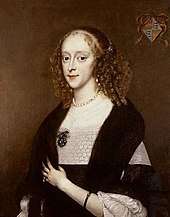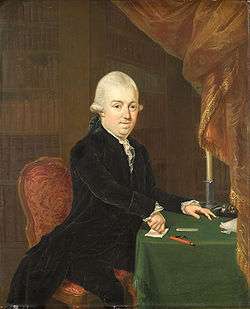Bicker family
Bicker (also: Bicker van Swieten and Bicker Caarten) is a very old Dutch patrician family (since 1390). The family has played an important role during the Dutch Golden Age. They were at the centre of Amsterdam oligarchy from the beginning of the 17th century until the early 1650s.[1] Since 1815 the family belongs to the new Dutch nobility with the honorific of jonkheer or jonkvrouw.[2]
| Bicker | |
|---|---|
| noble family | |
 | |
| Country | |
| Founded | 16th century |
The Bicker family during the Dutch Golden Age
During the Dutch Golden Age, the Bicker family was very critical of the influence of the House of Orange. They belonged to the republican political movement, also referred to as the ‘state oriented’, as opposed to the Royalists. Together with the Republican political leader Grand Pensionary Johan de Witt and the republican-minded Cornelis de Graeff, the Bickers strived for the abolition of stadtholdership. They desired the full sovereignty of the individual regions in a form in which the Republic of the United Seven Netherlands was not ruled by a single person. Instead of a sovereign (or stadtholder) the political and military power was lodged with the States General and with the regents of the cities in Holland. During the two decades from the 1630 to the 1650s the Bicker family had a leading role in the Amsterdam administration, the city was at the peak of its political power.[1]
In 1646, seven members of the Bicker family, called the Bicker's league, simultaneously held some political position or other. The Bickers provided silver and ships to Spain, and were very much interested in ending the Eighty Years War. This brought them in conflict with the stadtholder, some provinces, like Zeeland and Utrecht, and the Reformed preachers.[3] After the Peace of Münster (1648) was signed, the Bickers were of the opinion that it was no longer necessary to maintain a standing army, bringing them into vehement conflict with prince Willem II.[4] To regain power William went on the march towards Dordrecht and Amsterdam with an army. His troops got lost in a dense fog and were discovered by the postal courier on Hamburg. The mayors of Amsterdam had the civic guard called out, the bridges raised, the gates closed and the artillery dragged into position.
After that the leader of the family, Andries Bicker, was purged from the vroedschap, as was his brother Cornelis Bicker, as one of the conditions of the treaty that followed, led by Joan Huydecoper van Maarsseveen.[5] Henceforth, it was the equally republican-minded brothers Cornelis and Andries de Graeff, and their following, who dominated Amsterdam.[6] His niece Wendela Bicker married the raadspensionaris Johan de Witt.[7]
Family members
- Gerrit Pietersz Bicker (1554–1606), Burgemeester and councillor of Amsterdam, member and one of the founders of the Dutch East India Company (VOC)
- Andries Bicker (1586–1652), was a wealthy merchant on Russia, Amsterdam regent, burgemeester and member of the vroedschap, the leader of the Arminians, an administrator of the Dutch East India Company (VOC), representative of the States-General of the Netherlands, Lord of Engelenburg etc.
- Jan Bicker (1591–1653), Amsterdam politician, shipbuilder and merchant
- Wendela Bicker (1635–1668), wife of Johan de Witt
- Cornelis Bicker (1592–1654), Burgemeester of Amsterdam, Lord of Swieten, an administrator of the Dutch East India Company (VOC)
- Laurens Bicker (1563–1606), Dutch admiral, trader and merchant at Guinea
- Jacob Pietersz Bicker (1581–1626)
- Hendrick Jacobsz Bicker (1615–1651)
- Hendrik Bicker (1649–1718), Burgemeester of Amsterdam
- Hendrik Bicker (1682–1738)
- Jan Berend Bicker (1695–1750)
- Henrie Bicker (1722–1783)
- Jan Bernd Bicker (1746–1812), politician, member and president of the Batavian Republic's executive organ, the Staatsbewind
- Henrie Bicker (1722–1783)
- Hendrik Bicker (1649–1718), Burgemeester of Amsterdam
- Hendrick Jacobsz Bicker (1615–1651)
Gallery
 Gerrit Pietersz Bicker (1554-1604), Amsterdams Historisch Museum, 17th century
Gerrit Pietersz Bicker (1554-1604), Amsterdams Historisch Museum, 17th century Andries Bicker (1586-1652), painted by Bartholomeus van der Helst, Rijksmuseum Amsterdam (1642)
Andries Bicker (1586-1652), painted by Bartholomeus van der Helst, Rijksmuseum Amsterdam (1642) Gerard Andriesz Bicker (1622-1666), painted by Bartholomeus van der Helst, Rijksmuseum Amsterdam
Gerard Andriesz Bicker (1622-1666), painted by Bartholomeus van der Helst, Rijksmuseum Amsterdam Wendela Bicker (1635-1668), painted by Adriaen Hanneman, 1659
Wendela Bicker (1635-1668), painted by Adriaen Hanneman, 1659 Jan Bernd Bicker (1746-1812), painted in 1796
Jan Bernd Bicker (1746-1812), painted in 1796
Notes
- "Triumph of Peace". Archived from the original on 2012-03-01. Retrieved 2011-03-18.
- Nederlands adelsboek, p. 24
- Israel, J. (1995) The Dutch Republic, Its Rise, Greatness, and Fall 1477-1806. Clarendon Press, Oxford, p. 545.
- Israel, J. (1995) The Dutch Republic, Its Rise, Greatness, and Fall 1477-1806. p. 602.
- Israel, J. (1995) The Dutch Republic, Its Rise, Greatness, and Fall 1477-1806, p. 607.
- Israel, J. (1995) The Dutch Republic, Its Rise, Greatness, and Fall 1477-1806, p. 704.
- Panhuysen, L. (2005) De Ware Vrijheid, De levens van Johan en Cornelis de Witt. p. 181-183.
Literature
- Israel, Jonathan I. (1995) The Dutch Republic – Its Rise, Greatness, and Fall – 1477–1806, Clarendon Press, Oxford, ISBN 978-0-19-820734-4
- Rowen, Herbert H. (1986) John de Witt – Statesman of the "True Freedom", Cambridge University Press, ISBN 0-521-52708-2
- Zandvliet, Kees De 250 rijksten van de Gouden Eeuw – Kapitaal, macht, familie en levensstijl (2006 Amsterdam; Nieuw Amsterdam Uitgevers)
- Burke, P. (1994) Venice and Amsterdam. A study of seventeenth-century élites.
External links and Commons
| Wikimedia Commons has media related to Bicker (van Swieten). |